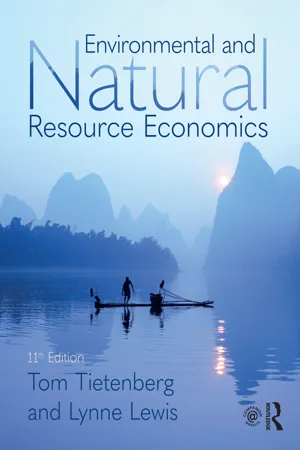
- 558 pages
- English
- ePUB (mobile friendly)
- Available on iOS & Android
Environmental and Natural Resource Economics
About this book
Environmental and Natural Resource Economics is the best-selling text for natural resource economics and environmental economics courses, offering a policy-oriented approach and introducing economic theory and empirical work from the field. Students will leave the course with a global perspective of both environmental and natural resource economics and how they interact. Complemented by a number of case studies showing how underlying economic principles provided the foundation for specific environmental and resource policies, this key text highlights what can be learned from the actual experience. This new, 11th edition includes updated data, a number of new studies and brings a more international focus to the subject. Key features include:
- Extensive coverage of the major issues including climate change, air and water pollution, sustainable development, and environmental justice.
-
- Dedicated chapters on a full range of resources including water, land, forests, fisheries, and recyclables.
-
- Introductions to the theory and method of environmental economics including externalities, benefit-cost analysis, valuation methods, and ecosystem goods and services.
-
- Boxed 'Examples' and 'Debates' throughout the text which highlight global examples and major talking points.
-
The text is fully supported with end-of-chapter summaries, discussion questions, and self-test exercises in the book and multiple-choice questions, simulations, references, slides, and an instructor's manual on the Companion Website.
Frequently asked questions
- Essential is ideal for learners and professionals who enjoy exploring a wide range of subjects. Access the Essential Library with 800,000+ trusted titles and best-sellers across business, personal growth, and the humanities. Includes unlimited reading time and Standard Read Aloud voice.
- Complete: Perfect for advanced learners and researchers needing full, unrestricted access. Unlock 1.4M+ books across hundreds of subjects, including academic and specialized titles. The Complete Plan also includes advanced features like Premium Read Aloud and Research Assistant.
Please note we cannot support devices running on iOS 13 and Android 7 or earlier. Learn more about using the app.
Information
Chapter 1
Visions of the Future
From the arch of the bridge to which his guide has carried him, Dante now sees the Diviners . . . coming slowly along the bottom of the fourth Chasm. By help of their incantations and evil agents, they had endeavored to pry into the future which belongs to the almighty alone, and now their faces are painfully twisted the contrary way; and being unable to look before them, they are forced to walk backwards.—Dante Alighieri, Divine Comedy: The Inferno, translated by Carlyle (1867)
Introduction
The Self-Extinction Premise
In the time of the poet it was crowned with the golden roofs of a temple; the temple is overthrown, the gold has been pillaged, the wheel of fortune has accomplished her revolution, and the sacred ground is again disfigured with thorns and brambles. . . . The forum of the Roman people, where they assembled to enact their laws and elect their magistrates is now enclosed for the cultivation of potherbs, or thrown open for the reception of swine and buffaloes. The public and private edifices that were founded for eternity lie prostrate, naked, and broken, like the limbs of a mighty giant; and the ruin is the more visible, from the stupendous relics that have survived the injuries of time and fortune.(Vol. 6, pp. 650–651)
Future Environmental Challenges
Climate Change
Evidence from the top of the atmosphere to the depths of the oceans, collected by scientists and engineers from around the world, tells an unambiguous story: the planet is warming, and over the last half century, this warming has been driven primarily by human activity—predominantly the burning of fossil fuels.
EXAMPLE 1.1
A Tale of Two Cultures
Water Accessibility
EXAMPLE 1.2
Climate Change and Water Accessibility: How Are these Challenges Linked?
Table of contents
- Cover
- Half Title
- Title Page
- Copyright Page
- Contents in Brief
- Contents in Full
- Preface
- 1 Visions of the Future
- 2 The Economic Approach: Property Rights, Externalities, and Environmental Problems
- 3 Evaluating Trade-Offs: Benefit-Cost Analysis and Other Decision-Making Metrics
- 4 Valuing the Environment: Methods
- 5 Dynamic Efficiency and Sustainable Development
- 6 Depletable Resource Allocation: The Role of Longer Time Horizons, Substitutes, and Extraction Cost
- 7 Energy: The Transition from Depletable to Renewable Resources
- 8 Recyclable Resources: Minerals, Paper, Bottles, and E-Waste
- 9 Water: A Confluence of Renewable and Depletable Resources
- 10 A Locationally Fixed, Multipurpose Resource: Land
- 11 Storable, Renewable Resources: Forests
- 12 Common-Pool Resources: Commercially Valuable Fisheries
- 13 Ecosystem Goods and Services: Nature’s Threatened Bounty
- 14 Economics of Pollution Control: An Overview
- 15 Stationary-Source Local and Regional Air Pollution
- 16 Mobile-Source Air Pollution
- 17 Climate Change
- 18 Water Pollution
- 19 Toxic Substances and Environmental Justice
- 20 The Quest for Sustainable Development
- 21 Visions of the Future Revisited
- Answers to Self-Test Exercises
- Glossary
- Index